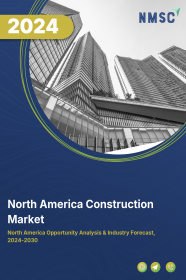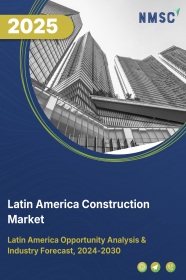
North America Construction Market by Type (Renovation, and New Construction), by Sector (Real Estate and Others), by Constructin Method (Traditional Construction, Prefabricated/Modular Construction, 3D Printed Construction, Green/Sustainable Construction), and by Type of Contractor (Large Contractor, Medium Contractor and Small Contractor) – Regional Industry Trends and Forecast, 2025–2030
Industry: Construction & Manufacturing | Publish Date: 21-Jun-2025 | No of Pages: 205 | No. of Tables: 160 | No. of Figures: 85 | Format: PDF | Report Code : CM2192
Industry Overview
The North America Construction Market size was valued at USD 2.58 trillion in 2024, and is projected to grow to USD 2.76 trillion by 2025. Additionally, the industry is expected to continue its growth trajectory, reaching USD 3.53 trillion by 2030, with a CAGR of 5.0% from 2025 to 2030.
The North America construction market is experiencing significant growth, driven by substantial government investments in infrastructure. These investments are focused on modernizing infrastructure, addressing environmental concerns, expanding high-speed internet, and transitioning to clean energy. Large-scale projects, such as the Site C Clean Energy Project and urban transit expansions, are contributing to this growth, while also promoting sustainable development.
However, the market faces challenges due to complex regulatory requirements and lengthy permitting processes, which can delay projects and raise costs. At the same time, the increasing adoption of Building Information Modeling (BIM) and advanced technologies like AI, IoT, and cloud solutions are presenting new opportunities to enhance project efficiency, collaboration, and management across the industry.
Government Investments in Infrastructure Boosts the North America Construction Market Growth
North America holds a prominent share of the construction market, largely driven by significant government investments. In 2024, the U.S. government allocated over USD 220 billion to support more than 32,000 projects across 4,500 communities, spanning all 50 states, the District of Columbia, and U.S. territories. These investments focus on modernizing infrastructure, replacing lead pipes, cleaning up pollution, expanding affordable high-speed internet access, and facilitating the transition to clean energy. Such funding is a key driver expected to stimulate revenue growth for market participants in the region.
Mega Projects Fueling North America Construction Market Trends
The North American construction industry is witnessing remarkable growth, fueled by considerable investments in large-scale projects aimed at improving connectivity, energy production, and urban development. In Canada, several high-profile megaprojects launched or advancing in 2024 and 2025 are contributing to this expansion. Notable initiatives include the Site C Clean Energy Project in British Columbia, which will generate renewable energy for approximately 450,000 homes annually; the GO Expansion On Corridor Works, which modernizes and expands the rail network across the Greater Toronto-Hamilton Area; and the Ontario Line subway in Toronto, aimed at alleviating congestion and improving public transit. These projects, supported by Natural Resources Canada, align with national infrastructure priorities and are driving sustainable economic growth and infrastructure solutions in the region.
Regulatory Complexities Impede Growth in the North America Construction Market Demand
The infrastructure industry faces significant challenges due to the complex web of government regulations and permitting processes. These projects often require a range of permits and approvals from local, regional, and national authorities, covering zoning regulations, environmental assessments, adherence to building codes, safety standards, and various other regulatory requirements.
Lengthy permit acquisition processes, bureaucratic inefficiencies, and regulatory discrepancies across jurisdictions can substantially delay projects and increase costs. Additionally, fluctuations in regulations or unexpected policy changes can disrupt ongoing projects and discourage potential investments.
Integration of Digitalization and BIM Presents Lucrative Opportunity for North America Construction Market Expansion
The industry for urban development projects is experiencing a major digital transformation, largely fueled by the growing use of Building Information Modeling (BIM), which is paving the way for new growth opportunities. BIM facilitates digital design, simulation, and management of infrastructure, enhancing accuracy, collaboration, and resource efficiency.
In line with this trend, ALLPLAN introduced Allplan 2024-1 in April 2024, aimed at advancing BIM functionalities and optimizing cloud-based workflows, highlighting the industry's shift towards fully digital project execution. Furthermore, the integration of AI, IoT, and cloud technologies is fostering real-time collaboration, enabling predictive maintenance, and improving facility management efficiency.
The U.S. Dominates the North America Construction Market Share
The U.S. holds a commanding share of the North American infrastructure market, driven by substantial investments in large-scale projects and ongoing infrastructure development. In 2024, several high-profile megaprojects are contributing to this expansion, including the Southeast Connector Project in the Dallas-Fort Worth area, the Madison Square Garden Sphere in Las Vegas, the Gordie Howe International Bridge in Detroit, the American Legion Bridge Replacement in Bethesda, the Related Santa Clara Project, the Hudson Tunnel Project in New York City, and the JFK Airport Expansion. These initiatives are key to the rapid growth of the U.S. infrastructure sector.
Furthermore, the infrastructure sector in the U.S. is currently experiencing significant growth, fueled by an increase in government-led initiatives to develop new infrastructure projects. These initiatives span various areas, including transportation infrastructure such as roads, bridges, and airports. In 2024 alone, the U.S. government allocated over USD 220 billion to support more than 32,000 projects across 4,500 communities in all 50 states, the District of Columbia, and U.S. territories. This funding is aimed at revitalizing and modernizing the nation's infrastructure, addressing issues such as lead pipe replacement, environmental cleanup, expanding access to affordable high-speed internet, and promoting the shift towards clean energy.
Mexico to Witness Substantial Growth in the North America Construction Market
The growth of Mexico's market is being propelled by the infrastructure of new manufacturing and industrial plants across the nation. According to Business Monitor International (BMI), Mexico’s infrastructure sector rebounded with a growth rate of 1.1% in 2024, and is projected to experience a steady average annual growth rate of 2.8% from 2025 to 2032. This projected growth trajectory indicates a favorable shift towards stability and expansion in Mexico's infrastructure sector.
The infrastructure industry in Mexico is experiencing notable expansion, fueled by increased investments in large-scale engineering projects and major infrastructure developments. Notable examples from 2024 include the Baja California Sur Combined Cycle Power Plant 327 MW, Tigres Football Club Stadium, Lerdo-Norte IV Combined Cycle Power Plant 350 MW, Marin Prefabricated Straight Beams Production Plant, and the Chihuahua Ophthalmic Lenses and Frames Manufacturing Plant Expansion. These significant projects are playing a crucial role in driving the growth of the infrastructure market within Mexico.
Competitive Landscape
The market players operating in the North America construction industry include Lennar Corp., D.R. Horton, Inc., Pultegroup, Inc., Jacobs Engineering, Fluor Corporation, AECOM, NVR, Inc., KBR, SNC-LAVALIN INC., Kentel Construction Ltd, PCL Construction, Graham Construction, Ledcor Group, Bird Construction, CICSA, IDEAL, Mota-Engil México, Techint Ingeniería y Construcción, Omega CORP, Pinfra, and others.
North America Construction Market Key Segments
By Type
-
Renovation
-
New Construction
By Sector
-
Real Estate
-
Residential
-
Affordable
-
Luxury
-
-
Commercial
-
Retail Buildings
-
Office Buildings
-
Hospitality
-
Healthcare Facilities
-
Educational Institutes
-
Entertainment Ventures
-
-
- Infrastructure
-
Transportation
-
Airport
-
Port
-
Rail
-
Road
-
-
Water and Wastewater
-
Energy
-
Telecommunication
-
- Industrial
-
Manufacturing Plant
-
Warehouses
-
Power Plants
-
Oil Refineries
-
Chemical Plants
-
By Construction Method
-
Traditional Construction
-
Prefabricated/Modular Construction
-
3D Printed Construction
-
Green/Sustainable Construction
By Type of Contractor
-
Large Contractor
-
Medium Contractor
-
Small Contractor
Key Players
-
Lennar Corp.
-
D.R. Horton, Inc.
-
Pultegroup, Inc.
-
Jacobs Engineering
-
Fluor Corporation
-
AECOM
-
NVR, Inc.
-
KBR
-
SNC-LAVALIN INC.
-
Kentel Construction Ltd
-
PCL Construction
-
Graham Construction
-
Ledcor Group
-
Bird Construction
-
CICSA
-
IDEAL
-
Mota-Engil México
-
Techint Ingeniería y Construcción
-
Omega CORP
-
Pinfra
REPORT SCOPE AND SEGMENTATION:
|
Parameters |
Details |
|
Market Size in 2024 |
USD 2.58 Trillion |
|
Revenue Forecast in 2030 |
USD 3.53 Trillion |
|
Growth Rate |
CAGR of 5.0% from 2025 to 2030 |
|
Analysis Period |
2024–2030 |
|
Base Year Considered |
2024 |
|
Forecast Period |
2025–2030 |
|
Market Size Estimation |
Trillion (USD) |
|
Growth Factors |
|
|
Countries Covered |
3 |
|
Companies Profiled |
15 |
|
Market Share |
Available for 10 companies |
|
Customization Scope |
Free customization (equivalent up to 80 working hours of analysts) after purchase. Addition or alteration to country, regional, and segment scope. |
|
Pricing and Purchase Options |
Avail customized purchase options to meet your exact research needs. |




















 Speak to Our Analyst
Speak to Our Analyst

























